Imagine being in a completely dark room. You can’t see anything, right? Now, if someone switches on a light, suddenly everything becomes visible. But what exactly is this “light” that makes everything visible to us? Let’s explore this concept.
Light is a form of energy that we can see. It’s what brightens our days and helps us see the world around us. But light is more than just what we see; it’s a type of electromagnetic radiation. Now, the term “electromagnetic radiation” might sound complex, but it’s simply a way of describing the energy that travels through space in waves.

These waves are all around us, but our eyes can only detect a small part of them. This small part is what we call visible light. Visible light includes all the colours we see in a rainbow – from red to violet. But, the electromagnetic spectrum, which is the range of all types of electromagnetic radiation, includes much more than just visible light. It also includes types of energy like radio waves, microwaves, infrared radiation, ultraviolet light, X-rays, and gamma rays. Each of these has its own unique properties and uses, but they are all related because they are all forms of electromagnetic radiation.
So, when we talk about light, we’re talking about a very special part of a much larger family of energies. This family helps us understand the universe in different ways, from listening to the radio to doctors looking inside our bodies using X-rays. But for now, let’s focus on light itself – the part of the electromagnetic spectrum that brings colours to our world and helps us see everything around us.
Table of Contents
Nature of Light
Now that we’ve introduced light as a part of the electromagnetic spectrum, let’s dive deeper into what light really is. Light has a very intriguing nature; it behaves both like a stream of tiny particles and like a wave. This might sound a bit puzzling at first, but let’s break it down.
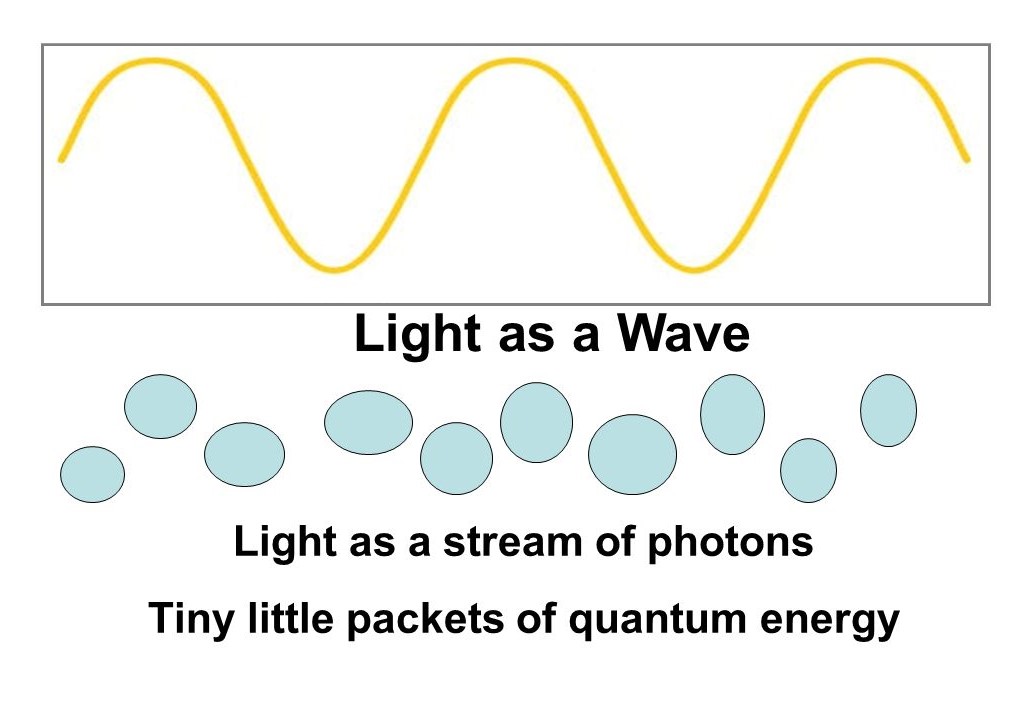
Light – Stream of Photons
When we think of light as a stream of particles, these particles are called “photons.” Imagine photons as incredibly tiny bundles of energy, so small that they don’t have any mass. That’s right, they weigh nothing at all! These photons are what carry light’s energy across space. Every time we see something lit up, it’s because photons are hitting it. They are like tiny messengers carrying the message of light from one place to another.
Light as a Wave
On the other hand, light also behaves like a wave. You’ve probably seen waves in the water, right? Light waves are similar, but they are waves of energy moving through space. These waves can vary in length, which is why we see different colours. Each colour of light we see in a rainbow has a different wavelength. Red light has longer waves, while blue or violet light has shorter waves.
The Wave-Particle Duality
Here’s where it gets really interesting. Light doesn’t just choose to be a wave or a particle; it can actually behave as both at the same time. This concept is known as the wave-particle duality of light. It’s a fundamental idea in the field of quantum physics, which deals with the very small parts of our universe.
The wave-particle duality tells us that light doesn’t fit neatly into just one category. Depending on how we observe it, it can appear as a wave or as a stream of particles. This duality is one of the most fascinating and mysterious aspects of light and of our universe. It shows us that even something as common as light can have surprising and complex behaviours.
In the next sections, we’ll explore more about how light behaves and interacts with everything it touches.
Properties of Light
Understanding light involves exploring some of its key properties. These properties help us to comprehend how light moves, changes, and interacts with the world. Let’s look at three important aspects: the speed of light, wavelength and frequency, and the electromagnetic spectrum.
Speed of Light
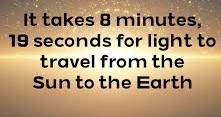
One of the most amazing things about light is how fast it travels. In a vacuum, where there is no air or other matter, light travels at an incredible speed of about 299,792 kilometres per second. That’s so fast that it can go around the Earth more than seven times in just one second! This speed remains constant in a vacuum, which is a space entirely empty of matter.
In different materials, like water or glass, light slows down a bit, but it’s still incredibly fast. This constant speed of light is a cornerstone in the field of physics and has helped scientists understand more about the nature of the universe.
Wavelength and Frequency

Now, let’s talk about wavelength and frequency. These two are like close friends that always go together. The wavelength of light is the distance between two consecutive peaks (or high points) of a wave. Imagine a wave in the ocean; the wavelength would be the distance from the top of one wave to the top of the next one.
Frequency, on the other hand, is how many waves pass a certain point in a certain amount of time, usually a second. It’s like counting how many waves hit the beach every second.
The interesting thing about wavelength and frequency in light is that they are inversely related. This means that if the wavelength is short, the frequency is high, and if the wavelength is long, the frequency is low. Different wavelengths and frequencies of light give us the different colours we see.
The Electromagnetic Spectrum
Remember how we said light is a part of the electromagnetic spectrum? This spectrum is like a big family of different kinds of electromagnetic radiation, including light. It ranges from very long radio waves to very short gamma rays.
Visible light, the light we can see, is just a small part of this spectrum. It sits somewhere in the middle, between infrared radiation (which we feel as heat) and ultraviolet radiation (which is responsible for sunburns). Each colour of visible light has its own wavelength and frequency. Red light has the longest wavelength and lowest frequency, while violet has the shortest wavelength and highest frequency.
In the next section, we’ll explore how light behaves when it meets different materials and surfaces.
Behaviour of Light
Now that we know what light is and some of its properties, let’s talk about how light behaves. Understanding the behaviour of light helps us make sense of many things we see everyday, like shadows, colours, and even how glasses help people see better.
Light Travels in Straight Lines
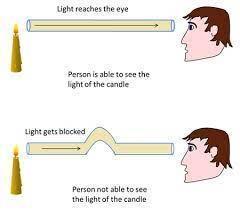
One fundamental aspect of light’s behaviour is that it travels in straight lines. This straight-line path of light is why we get shadows. When an object blocks light, it stops the straight path, creating a shadow on the other side. This is also why we can use mirrors to see around corners. The light bounces off the mirror and continues in a straight line, allowing us to see things reflected in the mirror.
Also Check – What is Light Reflection? A Simple Guide to Understanding Reflections
Reflection and Refraction
However, light doesn’t always just go straight. It can change direction in two main ways: reflection and refraction. Reflection is when light bounces off a surface. If the surface is smooth and shiny, like a mirror or calm water, the light bounces off in a very predictable way, allowing us to see reflections. If the surface is rough, light bounces off in many directions, and we don’t see a clear reflection.
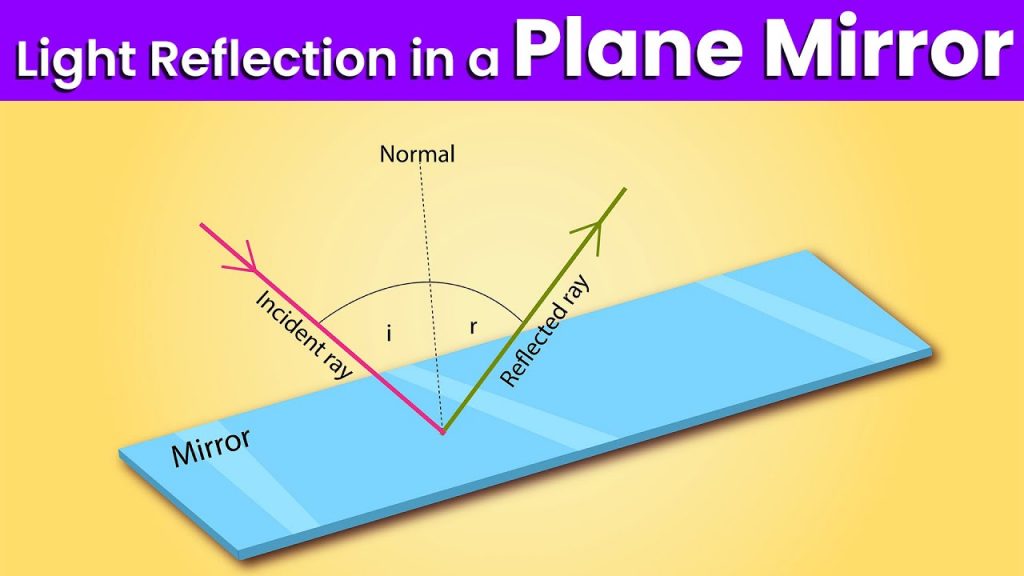
Refraction is a bit different. It happens when light passes from one material into another, like from air into water, and changes direction. This is because light travels at different speeds in different materials. A good example of refraction is when you put a straw in a glass of water. The straw looks like it’s bending at the surface of the water because the light is bending, or refracting, as it moves from the water to the air.
Also Check – Refraction of Light- A Comprehensive Guide for Students
Light at Boundaries
When light reaches the boundary between two different materials, three things can happen: it can be reflected back, transmitted through the material, or absorbed. If it’s transmitted, it might continue in a straight line or refract. If it’s absorbed, the light doesn’t come out the other side. The colour of objects is actually determined by which wavelengths of light they reflect and which they absorb. A green leaf, for example, absorbs all the colours of sunlight except green, which it reflects, making it appear green to our eyes.
So, light’s behaviour – travelling in straight lines, reflecting, refracting, and being absorbed – explains a lot about how we see the world. It’s why we see colours, images in mirrors, and why lenses can focus or spread out light. In the next section, we will delve deeper into how light interacts with different materials and how this affects what we see.
Also Check – Laws of Refraction- A High School Student’s Comprehensive Guide
Interaction of Light with Matter
After learning about the behaviour of light, it’s important to understand how light interacts with different materials. This interaction is key to why we see objects in various ways – some are clear, some are coloured, and some we can’t see through at all. Let’s explore how light interacts with three types of materials: opaque, transparent, and translucent.

Opaque Materials
First, we have opaque materials. These are the kinds of materials that don’t let any light pass through them. Think about a wooden door or a metal spoon. When light hits these objects, it’s either reflected back or absorbed. Since no light passes through an opaque object, you can’t see what’s behind it. This is why you get a shadow behind an opaque object when light shines on it – the light can’t go through, so it leaves a dark area behind.
Transparent Materials
Next, we have transparent materials. These materials let light pass through them almost completely. Glass and clear water are great examples of transparent materials. When light encounters a transparent material, it might bend a bit (remember refraction?), but mostly it goes straight through. That’s why you can see through windows or eyeglasses so clearly – the light isn’t being blocked or scattered much.
Translucent Materials
Finally, there are translucent materials. These are kind of in-between opaque and transparent. Translucent materials let some light through, but they scatter it in different directions. This scattering means you can’t see clearly through a translucent material. Think about frosted glass or thin paper. You might see light and some vague shapes through them, but not clear images like with transparent materials.
Why This Matters
The way light interacts with different materials is crucial for understanding how we see the world. It explains why some things are visible and others aren’t, and why objects have different colours and appearances. For example, a red apple is red because its surface reflects red light and absorbs other colours. A blue sky is blue because the atmosphere scatters blue light more than other colours.
Light Phenomena
Light is not just about illumination; it is also responsible for some beautiful and fascinating phenomena. By understanding reflection, refraction, and polarisation, we can appreciate many wonders of the natural world, including the colourful display of rainbows.
Reflection and Refraction
We’ve already touched on reflection and refraction, but let’s explore them with simple examples. Reflection is when light bounces off a surface. If you’ve ever seen your face in a mirror, that’s a reflection at work. The light from your face hits the mirror and bounces back to your eyes, allowing you to see your reflection.
Refraction, meanwhile, is when light bends as it passes through different materials. A classic example is a pencil in a glass of water. The pencil appears to be bent or broken at the surface of the water. This is because light bends when it moves from air (a less dense material) into water (a denser material), making the pencil look like it’s in a different position.

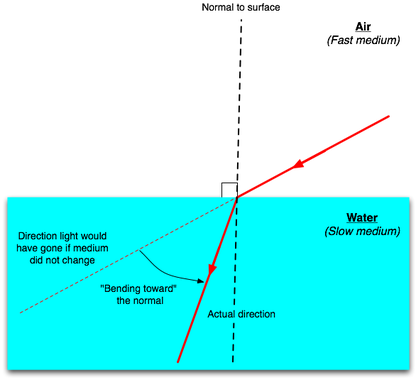
Polarisation
Polarisation is another intriguing aspect of light. It happens when light waves vibrate in just one direction. Normally, light vibrates in many directions, but certain filters, like those in polarised sunglasses, allow only light vibrating in a specific direction to pass through. This reduces glare from surfaces like water or roads, making it easier to see clearly. Polarisation is also used in photography to reduce reflections and enhance colours.

The Role of Light in Natural Phenomena
One of the most enchanting phenomena involving light is the formation of rainbows. A rainbow occurs when sunlight is refracted, or bent, and then reflected inside raindrops. Each colour in the sunlight bends by a slightly different amount when entering and leaving the raindrop. This separation of colours creates the spectrum we see in a rainbow. Red light bends the least, so it’s on the top of the rainbow, while violet bends the most and appears at the bottom.
Another example is the blue colour of the sky. The sky appears blue because molecules in the Earth’s atmosphere scatter sunlight. Blue light is scattered more than other colours because it travels as shorter, smaller waves. This is why we see a blue sky most of the time.

Practical Applications of Light
Light is not only fascinating to learn about; it also has many practical applications in our daily lives, in fields ranging from medicine and technology to scientific research. Understanding these applications helps us appreciate how integral light is to modern life.
Light in Medicine
In medicine, light plays a crucial role. For example, doctors use X-rays, which are a form of high-energy electromagnetic radiation, to look inside the human body. This allows them to diagnose broken bones and other internal issues without any surgery. Another example is laser surgery, where intense beams of light are used for precise surgical procedures, often leading to quicker healing and less pain.
Light in Technology
In the world of technology, light is everywhere. The screens of our smartphones, computers, and televisions use light to display images and information. Fibre optic cables, which are used for high-speed internet connections, work by transmitting light through thin fibres, carrying vast amounts of data over long distances. Without light, many of the devices and technologies we rely on daily wouldn’t work.
Light in Scientific Research
Light is also a key tool in scientific research. Telescopes use light to help us see distant stars and galaxies, expanding our knowledge of the universe. Microscopes use light to let us see tiny objects, like cells, that are too small for the naked eye, unlocking the secrets of biology. Scientists even use light in labs to study materials at the molecular and atomic levels, leading to new discoveries and innovations.
Everyday Experiences
These applications of light are not just limited to specialised fields; they impact our everyday experiences. When we get a medical scan, use the internet, watch TV, or even when looking at the stars, we are experiencing the practical uses of light. Light technology improves our health, connects us with others, entertains us, and helps us understand the world and universe we live in.
As we’ve seen, light is amazing. It’s more than just what helps us see; it’s a mix of waves and particles that moves incredibly fast and comes in different colours. Light makes rainbows, helps doctors see inside us, and lets us use things like phones and the internet. Every time we see something bright or colourful, we’re seeing light in action. Light is a big part of our world and it’s really important in many ways. It’s everywhere, making our world a bright and interesting place!
Curious Queries – Deeper into the Mysteries of Light
If light is made of photons, do photons have colour?
Photons themselves don’t have colour. The colour we perceive is due to the wavelength of the light that the photons are part of. Each colour corresponds to a different wavelength range within the visible light spectrum.
Can light bend around corners?
Generally, light travels in straight lines and doesn’t bend around corners. However, in certain advanced physics contexts, like in the study of gravitational lensing or wave optics, light can bend around objects due to the curvature of space or diffraction.
Is it possible to block light completely?
While opaque materials can block most visible light, completely blocking all forms of light (including all electromagnetic radiation) is extremely difficult. Even thick materials can sometimes allow a tiny fraction of light to pass through or around them.
Why can’t we see infrared or ultraviolet light?
Our eyes are only sensitive to a specific range of wavelengths in the electromagnetic spectrum – the visible light. Infrared and ultraviolet light have wavelengths outside this range, so our eyes are not equipped to detect them.
Can light ever stop moving?
Under normal circumstances, light is always in motion. The concept of light ‘stopping’ is not applicable in the traditional sense, as it contradicts the fundamental nature of light as defined by physics.
If light has no mass, how can it be affected by gravity?
According to Einstein’s theory of general relativity, gravity can bend the space through which light travels. This curvature of space changes the path of light, making it appear as if gravity is affecting the light itself.
Can anything travel faster than light?
According to current scientific understanding, nothing can travel faster than light in a vacuum. The speed of light is considered the ultimate speed limit in the universe.
How does light carry information in fibre optics?
In fibre optics, information is encoded in the light as variations in intensity or wavelength. These light signals travel through the fibre optic cables and are decoded at the destination to retrieve the information.


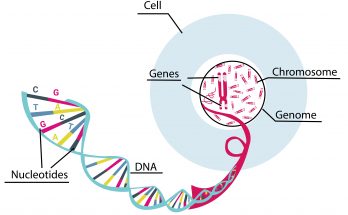
Wow… Amazing guide. Loved to read. Never understood light like this before. Thanks for capturing all the relevant information at one place. This kind of information will be helpful for understanding any topic. Please keep on writing and sharing this kind of guides.
Thanks Shrikant !